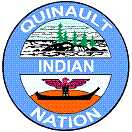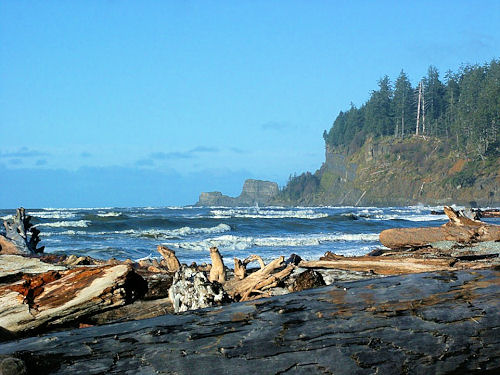- Hits: 11530
The Quinault Reservation is located in Washington State on the Olympic Peninsula. It is home to the Quinault and Queets tribes and descendants of five other coastal tribes: Quileute, Hoh, Chehalis, Chinook, and Cowlitz.
The Quinault constitute one of numerous Washington State native american tribes designated as Coastal Salish people.
The Quinault Indian Reservation is a land of magnificent forests, swift-flowing rivers, gleaming lakes and 23 miles (37 kilometers) of unspoiled Pacific coastline. Its boundaries enclose over 208,150 acres (84,271 hectares) of some of the most productive conifer forest lands in the United States.
Located on the southwestern corner of the Olympic Peninsula, its rain-drenched lands embrace a wealth of natural resources.
Conifer forests composed of western red cedar, western hemlock, Sitka spruce, Douglas-fir, Pacific silver fir and lodgepole pine dominate upland sites, while extensive stands of hardwoods, such as red alder and Pacific cottonwood, can be found in the river valleys.
Roosevelt elk, black bear, blacktail deer, bald eagle, cougar, and many other animals make these forests their home.

Quinault Indian Nation Logo
The Quinault Reservation is primarily in northwestern Grays Harbor County, with small parts extending north into southwestern Jefferson County.
Twenty-five thousand years ago, woolly mammoths roamed here as glaciers plowed the land, creating the rolling terrain which makes up much of the Reservation today. The glaciers also created Lake Quinault , the gem of Quinault country. The lake’s twelve miles (19.3 kilometers) of shoreline enclose 3,729 acres (1,509 hectares).
As a wet, mild climate began to evolve 12,000 years ago, the glaciers withdrew to the higher peaks of the Olympics. These conditions led to the development of forests of centuries-old trees, towering nearly 300 feet into the sky, and a land of untold forest resources.

Quinault Indian Nation Tribal Headquarters
There are approximately 2,385 enrolled Quinault tribal members. The Quinault Reservation has a resident population of 1,370 persons as of the 2000 census. The Quinault people settled onto reservation lands after signing the Quinault Treaty with the former Washington Territory in 1856. About 60% of the reservation’s population lives in the community of Taholah, on the Pacific coast at the mouth of the Quinault River. Other communities on the reservation include Amanda Park and Queets. Taholah contains the tribal headquarters.

Cape Elizabeth on the Quinault Indian Reservation where the Quinault River meets the sea
The word Quinault evolved from kwi’nail, the name of the tribe’s largest settlement once situated at present-day Taholah, at the mouth of the Quinault River.
The original Quinault language is a part of the Salishan family of languages. In modern times, remnants of six other tribes also live on the reservation, with languages from three separate language families: Chimakuan (Quileute, Hoh), Chinookan (Chinook groups), and Salishan (Chehalis, Cowlitz, Queets, and Quinault).
Contrary to what many non-indians think, per capita payments are not issued by the Federal Government. They are a disbursement of excess profits from successful tribally owned enterprises to their tribal members. The Quinaults do not receive per capita payments.
The Quinault Indian Nation is governed by an 11-member business committee, which confers with officers of a general council that represents all the tribes.
The tribe operates a variety of services and enterprises:
- Quinault Pride Seafood Products
- Quinault National Fish Hatchery
- Quinault Cultural Center (tribal museum in Taholah)
- Quinault Nation Tribal Health Facility
- Reservation police force
- Tribal court, including a chief judge and associate justices
- Head Start, and daycare centers in Taholah and Queets
- Elders Program
- Quinault Business Assistance Center
- Forestry programs
- Public works
- Quinault Housing Authority

